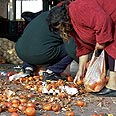
Report: 1 in 4 Israelis poor
National Insurance Institute's Poverty Report for 2008 shows number of needy residents in Israel relatively stable, despite financial crisis. There are 1,651,300 needy people living in Israel, including 783,600 children. Jerusalem is country's poorest district
Nonetheless, the data published Monday point to an extremely grim picture: There are 1,651,300 needy people living in Israel, including 783,600 children. The percentage of poor people in Israel dropped slightly to 23.7%. In other words, one in four Israelis is defined as needy.
According to NII officials, the financial crisis' influence, which was partly seen in the second half of 2008, compensated for the rise in income in the first half of the year. The results of the crisis erased the improvement in the dimensions of poverty among families and children. However, many families are now above the poverty line, thanks to allowances they are receiving.
The report points to a drop in the percentage of children living under the poverty line, which began in 2007, and dropped from 35.8% in 2006 to 34.2% in 2007 and 34% in 2008. While 17.8% of families with up to three children are under the poverty line, 57.8% of large families (with four children or more) are under the poverty line.
Many say that work can help remove families from a state of poverty, but the figures show that in nearly half of the families located under the poverty line (46.3%), the head of the family works. On the other hand, the number of families which don't work has been steadily decreasing over the past few years, but the high poverty rates among them continue to rise.
In 2006, 66% of these families were poor, in 2007 their poverty rate rose to 69.8% and in 2008 the figure increased even more to 71.4%.
Rise in number of poor in Tel Aviv
There are some encouraging figures as well. Poverty rates among Arab families dropped from 54% in 2006 to 51.4% in 2007 and to 49.4% in 2008. These drops, the NII explained, are mainly attributed to the rise in the number of breadwinners and in the income from labor among Arab families.
The poverty rates among elderly people remained almost unchanged at 22.7%. The percentage of needy single parents dropped from 29.8% in 2007 to 28.8% in 2008, but poor families became poorer: The poverty depth rose by four points over the years – a development which may be attributed to the dismissal of the household's only provider.
A geographical division of the findings shows that poverty rates dropped in all districts between 2007 and 2008, excluding Tel Aviv and southern Israel. Jerusalem is the country's poorest district - 32.3% of the capital's residents and almost 55% of its children are needy.
In the northern district, poverty rates dropped from 34.2% to 30.9%, and in the central district they dropped from 12.1% to 11.3%. In Tel Aviv poverty rates rose from 12.1% to 13.7%, and in southern Israel they rose from 23.2% to 23.6%.
Welfare and Social Affairs Minister Isaac Herzog said that the Poverty Report "points to a direct link between going out to work and emerging from poverty. Despite the financial crisis, the higher participation in the labor market, which characterized the Arab sector in 2008, led to a drop in the number of poor families in the Arab sectors. However, the depth of poverty worsened significantly among single parents due to dismissals.
"The current Poverty Report leaves no doubt as to the need to focus on encouraging employment, removing obstacles from the workers' employment field and developing diverse programs for special populations. This is what I plan to do."
And what is expected in the next report about 2009? NII officials say that on the one hand the employment rate has increased, and on the other hand the rise in allowances will be higher than the wage increase.
"A combination of these influences leads us to conclude that the poverty rates in 2009 are expected to be similar and even slightly lower compared to those of 2008," said one of the report's authors.










